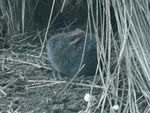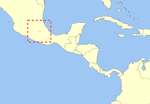Volcano rabbit
| Volcano rabbit |
|---|

|
| Scientific Classification |
|
| Binomial Name |
|
Romerolagus diazi [1] |
Volcano Rabbit is a unique rabbit found only in Mexico, in the central part of the Mexican Transverse Neovolcanic Belt. Unlike most rabbits, volcano rabbits have small round ears and tail that is sometimes not visible. With its small body, the volcano rabbit hides inside the bushes in its habitat. Volcano rabbits seem nice and well protected, but they have became an endangered species for a long time. People illegally hunt the volcano rabbit, decreasing its small population. Development around its habitat takes their home away, and sometimes forest fires make it hard to know the population.
Body Design
Volcano rabbits are one of the smallest rabbits in the world. They have very short round ears that are 40-44mm long,[2] and short legs and feet. Its body length is 27-36cm, and weight 400-600g. Volcano rabbits' tails are barely-visible or not visible. They have short, dense fur that is dark brown or black colored. Their fur can also be yellow on the back and side, and grey under-fur. Its colors blend in well with their habitat, which has volcano soils, enabling the rabbit to hide itself from predators.[3]
Life Cycle
Volcano rabbits live in groups of two to five in their runways and burrows. They are usually crepuscular, which means they are active after the sunset, but still move around during daytime, looking for food. Volcano rabbits eat plants that they can find around their habitat, such as tender green leaves of grass, young leaves of spicy herbs, dark of alder trees, and during rainy seasons, oats and corns.[4]
Volcano rabbits reproduce sexually throughout the year, but during warm and rainy summer months around March to July they reproduce more often. After the female gets pregnant it spends 40 days until the baby is born around their habitat making a nest for their babies to stay. They usually have one to two babies per litter, but may have three sometimes. When babies are born, they may stay in their nests for 2 to 3 weeks and start eating solid food around the third week. After 25 to 30 days, babies should be independent enough to start living by themselves, forming other groups.[3].
Ecology
Volcano rabbits are only found in Mexico. Most of them live in Zacatón, an area with lots of grass that has the right amount of food and hiding places for volcano rabbits.[2] They are mostly found on the volcano mountain near Mexico City. They are found between 2,800 and 4,250 m above sea level in pine forests with dense undergrowth of bunch of grasses and rocky substances.[3] They hide in grass that hides their small body well, and their fur is a similar color to their rocky habitat. Volcano rabbits are able to survive in these places because they has all of their hiding places and good resources for them to use to maintain their life.[2]
Endangered species
Volcano rabbits have a small population because they live only in Mexico. Because of illegal hunting, forest fires and property development, the volcano rabbit is now a endangered spices. Volcano rabbit is protected by Mexican laws against hunting, but there are still people hunting them illegally. Some of them were sent to a zoo in the United Kingdom, but they did not survive. Sometimes forest fires happen in the rabbit's habitat and it decreases the population.[5]
Video
This is a short video about volcano rabbits.
References
- ↑ Volcano Rabbit Wikipedia. Web. November 15th, 2015.
- ↑ 2.0 2.1 2.2 Unknown Author. Mammal Species EDGE. Web.
- ↑ 3.0 3.1 3.2 Smith, Andrew. Volcano Rabbit Wildscreen. Web. May 2nd, 2008.
- ↑ Unknown Author. Endangered species Animal info and endangered spices. Web. January 2, 2005.
- ↑ Unknown Author. Romerolagus diazi Red list. Web. June 30 2008.


